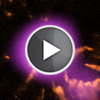CXC Home | Search | Help | Image Use Policy | Latest Images | Privacy | Accessibility | Glossary | Q&A
Tour of Abell 30
Quicktime MPEG
A planetary nebula is formed in the late stage of the evolution of a sun-like star, after it expands to become a red giant. These images show the planetary nebula A30, located about 5500 light years from Earth, which is going through a special, rarely-seen phase of evolution. The planetary nebula formed, but then the star briefly reverted to being a red giant. The evolution of the planetary nebula then restarted, making it reborn. Here is a close-up view of A30, showing X-ray data from Chandra in purple and optical data from Hubble in orange. A larger view shows optical and X-ray data from Kitt Peak and XMM-Newton, respectively, where the optical data is colored orange, green and blue, and X-ray emission is colored purple.
[Runtime: 01:04]
Quicktime MPEG
A planetary nebula is formed in the late stage of the evolution of a sun-like star, after it expands to become a red giant. These images show the planetary nebula A30, located about 5500 light years from Earth, which is going through a special, rarely-seen phase of evolution. The planetary nebula formed, but then the star briefly reverted to being a red giant. The evolution of the planetary nebula then restarted, making it reborn. Here is a close-up view of A30, showing X-ray data from Chandra in purple and optical data from Hubble in orange. A larger view shows optical and X-ray data from Kitt Peak and XMM-Newton, respectively, where the optical data is colored orange, green and blue, and X-ray emission is colored purple.
[Runtime: 01:04]
(Credit: NASA/CXC/A. Hobart)
Blowing Bubbles
Quicktime MPEG
Astronomers have captured a very special event in space: a so-called 'reborn planetary nebula'. This is a gas bubble inside a previously blown bubble, or nebula, like you can see in this image. Most stars turn into a nebula at the end of their lives, and sometimes, like in this case, they do the same thing twice.
When a star like our Sun has burned all of its fuel, it expands into an enormous red giant of more than ten times its original size. The star then has trouble holding on to its outer layers, which mostly blows off into space. Meanwhile, the leftover core attacks these loose layers with such intense radiation from the inside that it turns them into a planetary nebula - a colorful shining cloud of gas.
In rare cases, the core then performs the same trick: it expands and turns into a nebula. This time, we call it a 'reborn planetary nebula'. In comparison to a star's lifetime, nebulae (this is the plural word for nebula) last a very short while. They dissolve into space after just a few thousand years. This makes nebulae difficult to spot, and reborn nebulae even more so. Yet this time astronomers managed to catch one on camera!
[Runtime: 01:45]
Quicktime MPEG
Astronomers have captured a very special event in space: a so-called 'reborn planetary nebula'. This is a gas bubble inside a previously blown bubble, or nebula, like you can see in this image. Most stars turn into a nebula at the end of their lives, and sometimes, like in this case, they do the same thing twice.
When a star like our Sun has burned all of its fuel, it expands into an enormous red giant of more than ten times its original size. The star then has trouble holding on to its outer layers, which mostly blows off into space. Meanwhile, the leftover core attacks these loose layers with such intense radiation from the inside that it turns them into a planetary nebula - a colorful shining cloud of gas.
In rare cases, the core then performs the same trick: it expands and turns into a nebula. This time, we call it a 'reborn planetary nebula'. In comparison to a star's lifetime, nebulae (this is the plural word for nebula) last a very short while. They dissolve into space after just a few thousand years. This makes nebulae difficult to spot, and reborn nebulae even more so. Yet this time astronomers managed to catch one on camera!
[Runtime: 01:45]
(Credit: NASA/CXC/April Jubett)
Return to Abell 30 (November 15, 2012)




